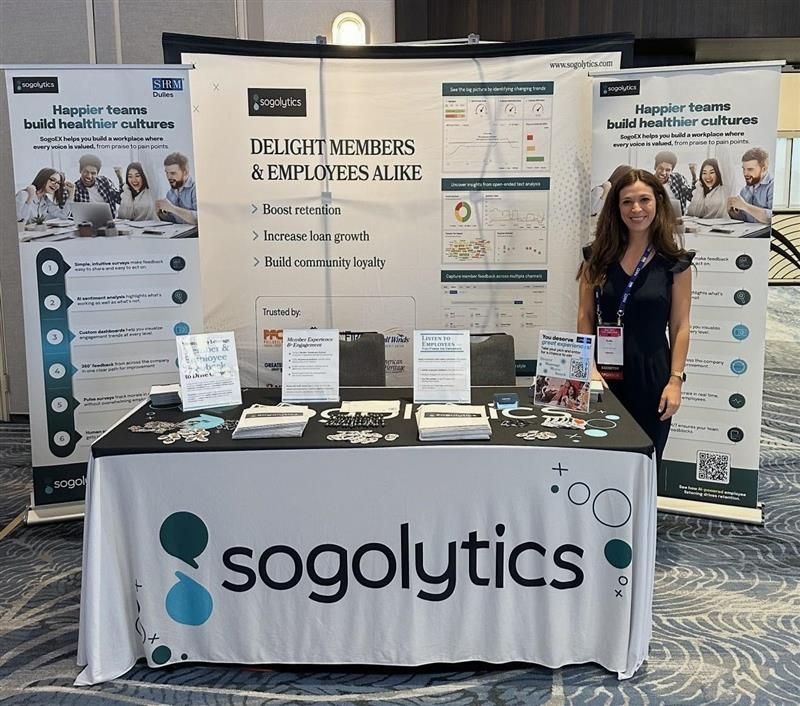Modern banks are enhancing the branch experience by connecting service quality to loyalty, satisfaction, and revenue growth. Learn data-backed strategies to elevate in-person banking, improve frontline performance, and turn everyday branch visits into opportunities for deeper engagement and long-term value.
Branch Experience Boosted by CX Tools
The digital world may dominate from an accessibility standpoint, but the bank branch is far from dead–it’s evolving. Branches continue to play a crucial role, particularly when it comes to complex transactions, building relationships, and creating moments that matter with customers.
When a customer steps into a branch today, they expect more. They want personalized, efficient, and knowledgeable support. They want to feel understood and to be valued. They want connection. The branch experience is shifting from transactional to relational and it’s time to get on board.
With rising expectations, delivering a high-quality branch experience is no longer optional. It has become a key opportunity to differentiate from the competition and that’s where Customer Experience (CX) tools can help.
By leveraging CX analytics, banks can gain real-time insights into branch performance, uncover pain points, and identify opportunities to enhance the customer journey. These tools enable institutions to align staff resources, streamline processes, and deliver experiences that build trust and long-term loyalty.
In this blog, we will explore data-backed strategies that elevate in-person banking and learn how CX analytics in banking can connect service quality to loyalty and sales, uncovering opportunities for your branch to optimize for the next evolution banking experience.
Why Branch Customer Experience Still Matters Today
Over half of the global population has a smartphone in their pocket. Convenience, speed, and customer expectation have driven the transactional side of banking online and this trend shows no signs of slowing down.
So, why does the branch CX even matter?
While digital tools are convenient for everyday banking, most customers still prefer human interaction when resolving issues or handling important financial matters. And we’re not just talking about balancing a checkbook.
According to McKinsey & Company, the financial industry is seeing convergence as more customers look to consolidate banking and more complex financial transactions like mortgages or wealth management under one roof.
And the more complex the transaction becomes, the more important trust–and relationship–becomes. In wealth management, in particular, about 63% of customers say they are loyal to an advisor (a relationship), not a firm.
That’s an opportunity to invest in customer loyalty banking.
While convenient, the most well-designed app or automation will never replace the connection between two people. Branches that are not capitalizing on in-person opportunities are fueling attrition.
High-stakes moments happen in person. When a customer needs to buy a home, resolve a dispute, or make an investment decision, emotions are elevated. These are moments when empathy and expertise matter. A cold, slow, or frustrating in-person interaction often leaves a lasting negative impression that erodes trust and hurts relationships.
On average, retail banks and credit unions lose around 15% of their customers annually. Missing key opportunities to earn trust and build relationships can drive that number even higher.
On the flip side, an elevated in-person experience fueled by data-driven design can increase customer retention and grow your brand. Retained customers are more cost-effective and profitable over time. Increasing customer retention by just 5% could translate to an increase in profits between 25-95%.
Key Challenges in Managing the Branch Customer Experience
While there is ample opportunity and a clear desire from customers for branches to embrace a relational approach, this shift is not without its challenges. Some things are just easier in the digital world–like capturing real-time customer sentiment and collecting holistic data for deeper analysis.
Real-Time Insights
The real world lacks embedded feedback tools. There is no facial recognition analytics or instant access to survey responses. If a customer is frustrated by a long wait, confused by a product, or upset by a staff interaction, it’s up to the staff to recognize the opportunity and respond appropriately–without data.
Even when looking for data, these interactions are limited to anecdotal accounts rather than hard numbers. As a result, these negative interactions most often go unnoticed or unaddressed, later showing up as a complaint, lost business, or a negative review.
Fragmented Data
Without a unified view, banks can’t truly understand customer behavior, preferences, or pain points. For example, a customer might start a loan application online, follow up in a branch, and then call support. If those touchpoints aren’t connected, no one sees the whole story.
Even when branches implement data collection systems for in-person interactions, the result tends to be disconnected and often disorganized. For branches, this means:
- Missed Opportunities for Personalization
- Repetitive or Frustrating Interactions
- Incomplete Data Driving Poor Decisions
- Less Loyalty and Lower Engagement
Fragmented data doesn’t just create internal inefficiencies, it directly impacts the customer experience.
Limited Visibility
The upside to the digital world is that every moment in time is automatically tracked, feeding rich data and real-time insights to any user with a credentialed login. The same is not true for branch experiences where visibility is limited to in-person observation and post-interaction feedback tools.
This creates downstream challenges for both data integrity and timely follow-ups. It’s simple, the memory of the human brain isn’t that reliable. Our short-term memory only retains core details for 15-30 seconds before they begin to get fuzzy. And long-term memory is typically minutes-to-hours before reliability begins to decay.
By the time that an in-branch customer is back in front of their email to respond to a satisfaction survey, it’s likely hours-or-days after the interaction–if at all. So even with tools and processes in place, it’s more challenging to see the whole picture when in-person interactions are part of the mix leading to a disconnected in-branch experience.
Leveraging CX Analytics to Transform Branch Banking
We’ve established that there is immense value in cultivating top-notch in-branch customer experiences. But also, being realistic, we’ve identified some of the not-so-comfortable challenges of managing in-branch experiences. The good news–CX analytics platforms bridge the gap.
Customer Experience (CX) analytics refers to the tools and processes banks use to gather and analyze data across multiple touchpoints to better understand and improve their customer journey.
How a CX Analytics Platform Works
You might recognize platforms like Sogolytics, Medallia, Qualtrics of which are CX Analytics solutions designed to collect and streamline customer data to provide timely, actionable insights to drive business decisions.
For example, Medallia can collect feedback in real-time using multiple channels (surveys, social media, app interactions), use AI to analyze feedback for sentiment, and trigger real-time alerts or visual dashboard updates making that information immediately available to managers and key decision makers within the bank.
This means that when a customer walks into a branch an in-person interaction tied to a digital event like looking up the customer’s account in the bank’s core banking system triggers an automated follow-up.
Within thirty minutes, the customer receives a text on their smartphone with an immediate feedback request. Low scores on that feedback request flag a real-time alert, notifying the branch manager and prompting a more personal follow-up.
Over time, this data is aggregated to provide front-line-service visibility, feeding into the bank’s continuous process improvement system.
What a CX Analytics Platform Can Track
The nuts-and-bolts of what a platform offers will depend on the build. As a generalization, most software solutions designed for this purpose can collect, track, and visualize feedback, customer behavior, and operational activities, including things like:
- Collect Customer Feedback
- Analyze Sentiment & Emotion
- Track Customer Journeys
- Track Service Metrics
- Collect Data on Frontline Performance
- Uncover Trends & Patterns
Let’s say that your branch uses a platform like Qualtrics. When a customer walks in a branch, a staff member will use the banks’ core banking system to retrieve their account, log their interactions, and complete actions based on what services the customer is utilizing during the visit.
The CX Analytics software has a direct integration to the core banking system so any information recorded in one system is available to the other. When the banker tags the interaction indicating that the customer asked about a small business loan, a follow-up is triggered in the CX platform that sends an email or a text to the customer following up on their interest in that product.
This automation is combined with a satisfaction survey based on the customers’ recent visit. When that feedback is returned, the system analyzes sentiment and recognizes high-probability opportunities for cross-selling in banks, flagging those for follow-up by the appropriate department.
Using Data to Fuel Customer Loyalty Banking
Automated follow-up and streamlined follow-through processes are just the beginning of what is possible with a robust CX Analytics platform. With the ability to effortlessly and effectively collect data across multiple channels, banks can monitor their Net Promoter Score, customer satisfaction scores, and service recovery metrics for a stronger, more strategic competitive position.
From there, personalizing experiences based on past behavior and preference data becomes a breeze. For example, if a customer uses their banking app to convert money to international currency and visits a branch to inquire about international credit cards, these are strong signals that the customer is planning to travel abroad.
An automated process can recognize these patterns and trigger a relevant email offer for low-rate international credit cards. How that customer responds to that email can then trigger a warm-lead follow-up from a personal in-branch banker.
Instead of starting that conversation with ‘how can I help you,’ the banker can effortlessly make a connection that feels personal and steer the conversation directly to opportunities that are of high interest to that customer.
The result is like magic–the customer feels seen and heard, eager to move forward and pleased with the experience. And that’s just one example–imagine if you had this level of insight on every customer that walked into your branch today.
Turning Branch Visits into Sales Opportunities with CX Data
The opportunities to wow your customers with next-level service are endless when you have the right information. For starters, CX Analytics platforms empower staff with dashboards and in-branch cues for upselling making sure that there is never a missed opportunity to meet needs. In turn, those met needs turn directly into revenue dollars through increased demand for cards, loans, or advisory services.
Beyond upselling, CX data also helps staff personalize conversations in real-time, anticipating questions, addressing concerns, and guiding customers toward the right solutions without the hard sell. So it’s not just about getting more revenue per transaction, it’s about extending mileage too.
Moreover, aggregated branch inasights allow regional managers to identify which locations are outperforming others and why—creating opportunities to replicate success across the network. Over time, these data-driven conversations shift branches from being reactive service centers to proactive growth engines.
With the right customer experience tools in place, every interaction becomes more than a transaction, it becomes an opportunity to deepen and grow a relationship that endures.
Bottom Line–Banking is Evolving (Again)
The role of the bank branch is far from obsolete. In-person experiences still carry incredible value, especially when supported by real-time insights and customer-centric strategies. Banks that invest in CX analytics gain a clear advantage: they can personalize service, close experience gaps, and turn everyday visits into lasting relationships.
Adopting customer experience tools in banking might be the smartest thing you can do to boost your customer experience.
FAQs
1. What defines a great bank branch experience today?
A: A great branch experience is defined by personalization, efficiency, and trust. This requires a human-centered approach. Customers expect service that feels tailored to their needs but also need their time to be respected. Quick, frictionless service that feels warm and personal is the key to creating a great experience.
2. How does CX analytics help improve branch performance?
A: CX analytics helps improve branch performance by turning customer feedback, behavioral data, and operational metrics into actionable insights. Banks can identify common pain points, track service consistency, and monitor staff performance in real time. This visibility allows branch managers to quickly address issues, coach employees more effectively, and replicate best practices across locations.
3. What KPIs should banks track in branches?
A: Banks should track a mix of experience, operational, and performance-related KPIs to understand and improve service and operational effectiveness. Key customer experience metrics include: Net Promoter Score (NPS), Customer Satisfaction (CSAT), and Customer Effort Score (CES). Operational KPIs include metrics like wait time, service duration, and queue length which help measure efficiency.
3. What’s the difference between customer journey mapping and feedback-driven journey optimization?
A: Customer journey mapping is all about picturing the customer’s experience by identifying and addressing pain points and emotions connected to how one’s business deals with the problematic issues. Optimization focuses on the actions the map indicates are essential, using relevant data to test and improve interactions and customer engagement.
4. Which tools are best for measuring customer experience in banking?
A: There are several leading tools all well-suited for measuring customer experience in banking, offering the ability to capture feedback, analyze behavior, and drive action. Medallia, Qualtrics XM, and Verint are among the most widely used customer experience tools.
5. How can branches use CX data to increase cross-selling?
A: Customer experience tools in banking can help identify customer needs, preferences, and pain points in real time. This data can then be articulated to identify which products or services might be the best fit for a customer. These platforms can also highlight patterns and trigger actions resulting in detailed and highly personalized interactions.














